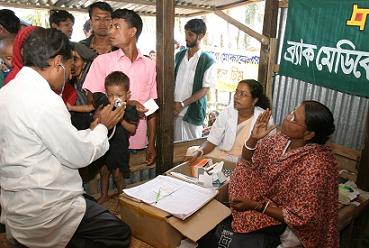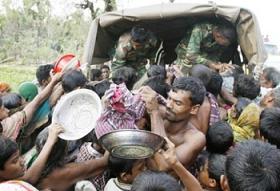CYCLONE SIDR AND IT’S AFTERMATH
“Viewpoint”
4 december 2007
By Lutfur Rahman
Canada – Another cyclone has come and gone leaving it’s trail of death and destruction . The grisly horror of mangled bodies and floating animal carcasses and the images of destitute humanity have once again filled the world’s newspapers and TV screens.

Photo: BRAC medical team attending to cyclone victims in Telikhali in Bhandaria, Pirojpur
As in the past, USA has sent in their war ships with helicopters and relief goods, India and Pakistan have sent in their planes loaded with food and medicine, and many others, from near and far afar, have rushed in with the necessities of life. With the helping hands of the world and the efforts of the government, hopefully, the latest of the heart wrenching pain and suffering of our coastal people will subside and fade from our memory, once again, and life will return back to it’s marginal best once more.
But that would not be end of the story. With the dire predictions of the scientific communities about what lies ahead for the planet as a whole, and the ground realities that is our lot in the world’s greatest deltaic region, this is not even be the beginning of the story.
All indications are such tragedies are likely to be regular feature of our existence at the lapping edge of the rising tides, more to be prevalent in the future than in the past, with each episode likely to outstrip it’s predecessor in fury and destruction.
That being the grim view of the future the burning question that begs asking is what are we going to do about it. Or is there anything that can be done other than sitting in stoic silence against nature’s onslaught that is surely to come again?.
The causes of the problem are many and varied and the remedies are far and few, mostly beyond the capacity of present day human control. The greenhouse effect and warming of the planet, the denudation of the lands and forests, the damming of the rivers, destruction of the ecological balance of the planet are all contributing factors that require a concerted global effort to make any headway, which is a non starter in the present day geo politics of the world. But there are areas of the over all problem that manifests in great loss of life, that are within the grasp of humanly endeavor to mitigate, even of our own.
When better preparedness in way of more cyclone shelters, better communication and warning facilities would help curtail the death and destruction it is also a fact the most of the death and destruction is due to the presence of a very high level of population density that toils in these areas of high risk, in subsistence level of existence. Being forced to eke out a marginal livelihood in fishing or in agriculture, on tidal mud flats in such great numbers with women and children is asking for trouble, storm or no storm.

Tafalbari
Photo: Reuters
What is most urgently needed is a crash program in arresting the population growth and it’s ultimate reversal in a bid to lower the population density of the country. In spite of the tremendous fertility and the bounty of the land, the country is blessed with, the galloping birth rate and the resultant population density is far too great by all standards of measure and should be reduced considerably for a meaningful sustenance of human life in the land. With the predicted sea level rise and further loss of habitable and agricultural land, this is not an option that can be ignored anymore if we really want to mitigate the situation in a meaningful way.
With a forward looking government, now at the helm, this is perhaps an opportune time for making a sincere effort toward that goal. Formulating and adopting workable strategies towards arresting and reversing the population growth, in a country like Bangladesh, is a task that is perhaps easily said than done. However, considering what is at stake , the government has every reason to try to mobilize public opinion, in it’s favor, through open dialogue and discussions with every section of the population including the religious clergy, the educationists, the civil servants, civil societies, NGOs, the business people and the general public.
What is needed is a proactive, result orientated, comprehensive plan of action that would include not only rolling back the population density but also setting up a national agenda (and a road map) for achieving a truly progressive democratic system of government addressing all aspects of national life that play critical roles in nation building, such as.
Fitting education and skill development for a global world
People orientated police, judiciary and administration
Health and nutrition, sanitation and hygiene, sports and recreation
National registry for birth death and marriage
Environment protection and ecological balance
Democratic norm, press freedom, transparency and freedom of information
Religion free politics, morality and nationalism,
Government of merit and ability, discipline and accountability
Etc.
The viability of the state and the sustainability of it’s quality and character will greatly depend on how the present government, and the ones that would follow, adhere to and succeed in curtailing the population growth along with instilling the requisites of a free and fair, just and equitable, disciplined and accountable form of government that has been the demand of all Bangladeshis for such a long time .
Mail :mlr_ca2003@yahoo.ca
Source: www.bangladesh-web.com




